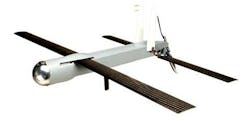BAE Systems to develop ASW drone to help Navy P-8A hunt enemy subs from altitude
Officials of the U.S. Office of Naval Research (ONR) in Arlington, Va., announced an $8.9 million contract to the BAE Systems Electronic Systems segment in Merrimack, N.H., for the High Altitude ASW (HAASW) Unmanned Targeting Air System (UTAS) program for the Navy Boeing P-8A Poseidon maritime patrol jet.
HAASW UTAS seeks to integrate a magnetic anomaly detector (MAD) and algorithms for use on an air-launched drone that the P-8A will use to detect and pinpoint enemy submarines.
A MAD instrument detects minute variations in the Earth's magnetic field. A submerged submarine represents a mass of ferromagnetic material that creates a detectable disturbance in the Earth's magnetic field.
The Navy's predecessor to the P-8A -- the Lockheed Martin P-3 Orion four-engine turboprop aircraft -- has a MAD sensor attached to the back that looks like a large stinger that protrudes backward from the plane's tail.
The P-8A -- a maritime patrol version of the Boeing 737-800 single-aisle passenger jet -- was designed without the built-in MAD instrument largely because the P-8 is designed to operate primarily at high altitudes. The MAD sensor works best at low altitudes.
To compensate for the lack of a built-in MAD instrument, the P-8 will use an unmanned drone equipped with the HAASW UTAS MAD sensor and algorithms.
Although the P-8A is capable of low-altitude operations, it is designed primarily for use at relatively high altitudes to enable the aircraft to keep watch over large ocean areas and fly as fuel-efficiently as possible.
The plane is being designed not only with the HAASW UTAS to enable the aircraft to use a MAD instrument from high altitudes, but also with sonobuoys designed to launch from high altitudes and cover large areas of the ocean.
The P-8A also is being equipped with a flying torpedo called the High Altitude Anti-Submarine Warfare Weapon Capability (HAAWC) Air Launch Accessory (ALA) that can be released from altitudes as high as 30,000 feet.
These high-altitude torpedoes are Navy Mark 54 lightweight torpedoes with add-n kits that enable the weapons to glide through the air to attack enemy submarines from long ranges and high altitudes.
Fixed-wing aircraft like the P-3 normally release conventional torpedoes from very low altitudes or with small parachutes to ease the torpedoes into the water gently.
The HAAWC ALA turns the Raytheon Mark 54 torpedo into a glide weapon. As the flying torpedo reaches the water, it jettisons wings and other air-control surfaces and takes on its original role as a smart torpedo that can detect, track, and attack enemy submarines autonomously.
The P-8A also is being designed to work together with the Northrop Grumman RQ-4N Triton Broad Area Maritime Surveillance (BAMS) large UAS -- a maritime-patrol version of the Global Hawk long-range surveillance UAS.
One or more Triton UAS can detect and track hostile submarines from high or low altitudes, and the P-8A can look for submerged submarines and launch torpedo attacks from high altitudes. The MAD instrument-equipped HAAWC ALA drone will add to the new P-8A's ASW capabilities.
For more information contact BAE Systems Electronic Systems online at www.baesystems.com, or the Office of Naval Research at www.onr.navy.mil.
About the Author
John Keller
Editor-in-Chief
John Keller is the Editor-in-Chief, Military & Aerospace Electronics Magazine--provides extensive coverage and analysis of enabling electronics and optoelectronic technologies in military, space and commercial aviation applications. John has been a member of the Military & Aerospace Electronics staff since 1989 and chief editor since 1995.
